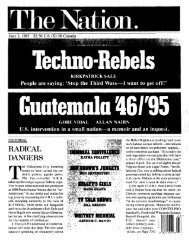Illan Nam, Colgate University, Feb 2011Draft <strong>in</strong> progress, please do not quote or citelanguage of the debate about the state and its responsibilities for social welfare spend<strong>in</strong>g.Whereas dur<strong>in</strong>g the 1970s and even 1980s, the notion of state responsibility for welfareprovision<strong>in</strong>g would have struck ord<strong>in</strong>ary citizens <strong>in</strong> Korea and Taiwan as unfamiliar oreven as an “unpatriotic” burden that impeded the state’s more urgent and overrid<strong>in</strong>gobjective of pursu<strong>in</strong>g national economic growth, by the 1990s, citizens’ attitudes hadshifted dramatically. Leftist newspapers, <strong>in</strong>tellectuals and activists, and civil societyorganizations stridently called upon the state to deliver protection to vulnerable citizensand to create a nation based on socioeconomic equality.Welfare state development <strong>in</strong> Lat<strong>in</strong> America and <strong>East</strong> <strong>Asia</strong> are marked by twodist<strong>in</strong>ct outcomes. The first is along the dimension of universality of access, and thesecond along the dimension of solidarity or redistribution. Among the patterns thatemerge, we f<strong>in</strong>d that <strong>in</strong> several countries <strong>in</strong> <strong>East</strong>/Southeast <strong>Asia</strong> – Thailand, South Korea,and Taiwan – over the course of the 1990s and 2000s, more and more citizens came tobenefit from a universal access to healthcare. Whereas the reach of the healthcareprograms previously had been conf<strong>in</strong>ed to a select group of formal sector workers,benefits were expanded to encompass more segments of the population, most notably therural and <strong>in</strong>formal sector workers. However, we also f<strong>in</strong>d that reforms that greatlyimproved the solidarity and equity of programs were undertaken <strong>in</strong> only some <strong>East</strong> <strong>Asia</strong>ncountries. For <strong>in</strong>stance, while <strong>in</strong> Korea and Taiwan, s<strong>in</strong>gle-payer national funds wereestablished that enhanced the solidaristic elements of healthcare <strong>in</strong>surance across bothformal and <strong>in</strong>formal sector workers, <strong>in</strong> Thailand, separate programs cont<strong>in</strong>ued to bema<strong>in</strong>ta<strong>in</strong>ed for formal sector workers.4
Illan Nam, Colgate University, Feb 2011Draft <strong>in</strong> progress, please do not quote or citeIn contrast, <strong>in</strong> Lat<strong>in</strong> America, dur<strong>in</strong>g the 1980-90s, most countries put <strong>in</strong> place amixed system of private-public health systems. While healthcare systems <strong>in</strong> thesecountries ostensibly extended access to all citizens, <strong>in</strong> reality, coverage <strong>in</strong> many countriesfell short of be<strong>in</strong>g universal. Moreover, <strong>in</strong>evitably, lower-<strong>in</strong>come citizens were pricedout of the private system and came to be concentrated <strong>in</strong> the public health sector,burden<strong>in</strong>g the latter with a greater pool of higher-risk patients and creat<strong>in</strong>g a dual systemof care that discrim<strong>in</strong>ated between higher- and lower-<strong>in</strong>come citizens. As a result, poorercitizens often faced healthcare provision<strong>in</strong>g that was plagued by lower quality services,overcrowd<strong>in</strong>g, and lack of capacity. Policymakers sought to ameliorate some of theseproblems through measures that improved access, particularly for the lowest <strong>in</strong>comegroups. On the other hand, efforts at <strong>in</strong>tegrat<strong>in</strong>g the public and private systems havebeen far more limited, and hence, the degree of redistribution or equity with<strong>in</strong> thehealthcare system is low.Why do we see variation with respect to these two dimensions of healthcarereform, both with<strong>in</strong> as well as across regions? I argue that the divergence <strong>in</strong> policyoutcomes depended upon two factors: first, the nature of electoral party competition <strong>in</strong>these new democracies provided different <strong>in</strong>centives and payoffs to parties forimplement<strong>in</strong>g universal versus targeted social policies. I claim that where party systemsare less <strong>in</strong>stitutionalized, have weakly nationalized presences, and are underp<strong>in</strong>ned byanemic or fluid partisan attachments, a universaliz<strong>in</strong>g social policy <strong>in</strong>itiative is morelikely to yield greater electoral payoffs. In this k<strong>in</strong>d of electoral landscape, sweep<strong>in</strong>gsocial policy <strong>in</strong>itiatives may be efficacious means of replac<strong>in</strong>g clientelistic networks oroverlay<strong>in</strong>g new socioeconomic cleavages that create more programmatic partisan5
- Page 1 and 2: Illan Nam, Colgate University, Feb
- Page 3: Illan Nam, Colgate University, Feb
- Page 7 and 8: Illan Nam, Colgate University, Feb
- Page 9 and 10: Illan Nam, Colgate University, Feb
- Page 11 and 12: Illan Nam, Colgate University, Feb
- Page 13: Illan Nam, Colgate University, Feb
- Page 16 and 17: Illan Nam, Colgate University, Feb
- Page 18 and 19: Illan Nam, Colgate University, Feb
- Page 20 and 21: Illan Nam, Colgate University, Feb
- Page 22 and 23: Illan Nam, Colgate University, Feb
- Page 24 and 25: Illan Nam, Colgate University, Feb
- Page 26 and 27: Illan Nam, Colgate University, Feb
- Page 28 and 29: Illan Nam, Colgate University, Feb
- Page 30 and 31: Table 2 - Electoral Volatility Acro
- Page 32 and 33: Illan Nam, Colgate University, Feb
- Page 34 and 35: Illan Nam, Colgate University, Feb













